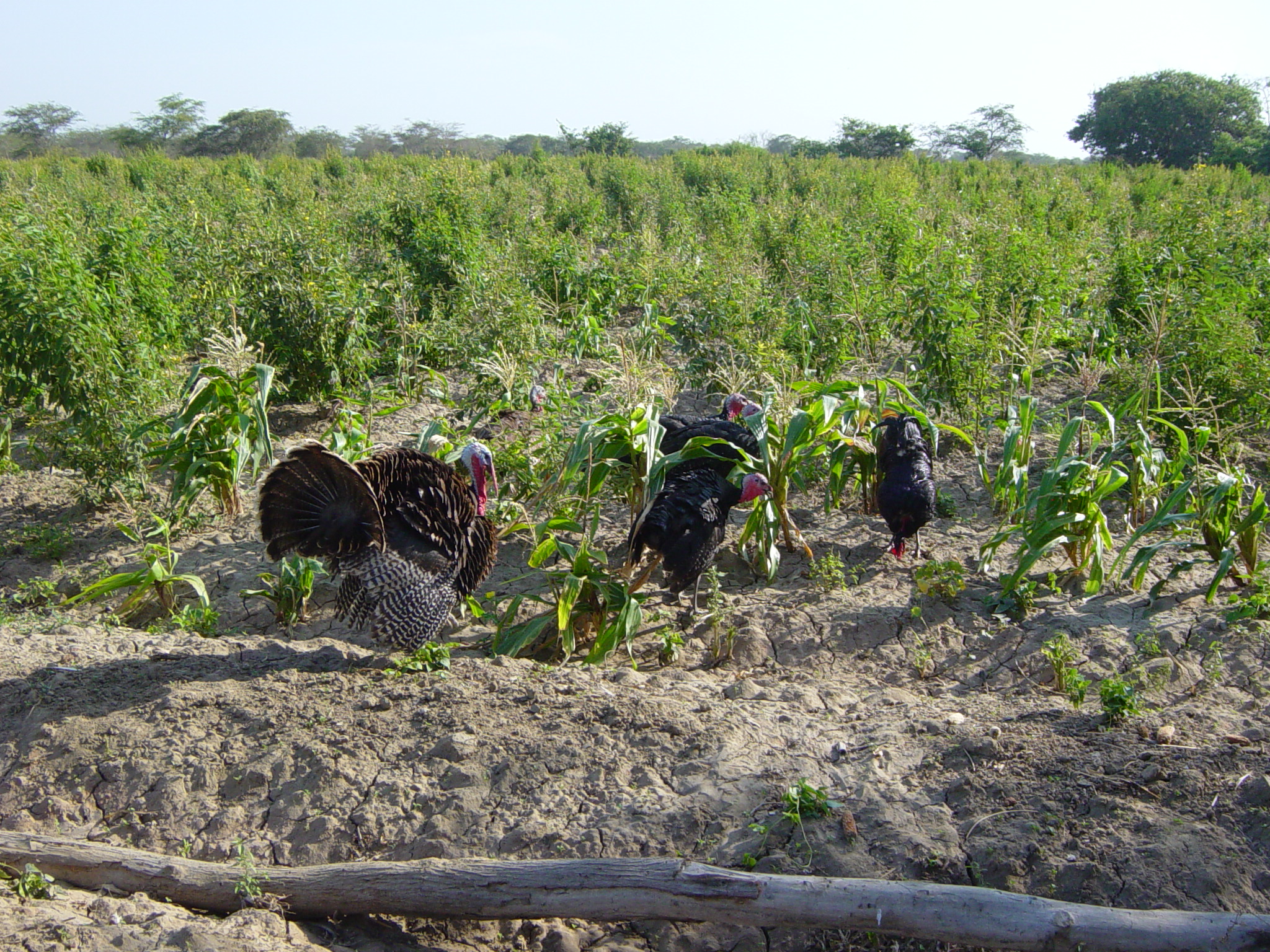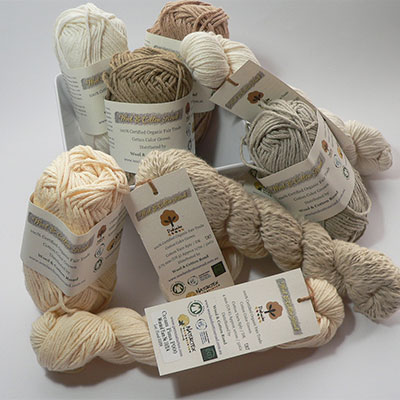Quality – organic cotton is naturally more durable.
Good Conductor of Heat - Cotton keeps the body cool in summer and warm in winter.
Non-allergenic – natural fibre that doesn’t irritate sensitive skin.
Environmentally safe – Certified organic cotton leaves no harmful side effects.
Socially responsible – every time we purchase Certified organic we are helping to build a better world.
Fair Trade – improved living standards of the farmers and their families producing Certified organic cotton.
Not genetically modified – Certified organic cotton yarn has been grown from seed that has not been genetically modified.
What is certified organic cotton?

It is cotton that is grown using methods and materials that have a low impact on the environment. Organic production systems replenish and maintain soil fertility, reduce the use of toxic pesticides and fertilisers, and build biologically diverse agriculture. Domestic turkeys devour large cotton insects.
Photo courtesy of Dr. James M. Vreeland Jnr. Naturtex
Third-party certification organisations verify that organic producers use only methods and materials allowed in organic production.
In fact, companies are increasingly becoming certified to traceability standards such as the Organic Exchange (OE) Blended or OE 100 standard, tracing the organic fibre from the field to finished product. Many manufacturers have also become certified to the Global Organic Textile Standard (GOTS), which addresses textile’s processing stages and includes strong labour provisions. (Organic Trade Association)
Properties of Cotton
-
Cotton is a non-allergenic natural fibre that doesn’t irritate sensitive skin.
- Natural Cotton is one of the easiest fabrics/yarns to dye, because of its whiteness and absorbency.
- Cotton keeps the body cool in summer and warm in winter because it is a good conductor of heat.
- Cotton breathes easily as a result of its unique fibre structure. This attribute makes cotton more comfortable to wear than artificial fibres unable to provide ventilation.
- Cotton’s softness makes it a preferred fabric for garments worn close to the skin.
- Cotton’s adaptability allows it to blend easily with most other fibres such as natural fibres like wool.
- Cotton has a high absorbency rate and holds up to 27 times its own weight in water.
- Cotton becomes stronger when wet.
- Unlike synthetic fibres, cotton is a natural product and contains no chemicals.
- Cotton is very versatile – it can be blended, coated, finished, is dry cleanable, machine washable and easy to print on.(Cotton Australia)
 Pakucho Certified Organic Colour Grown Cotton
Pakucho Certified Organic Colour Grown Cotton
Cotton Industry
Organic cotton in 2004 constituted a mere 0.1% of all cotton grown, it was obvious that the world’s demand for cotton could not be satisfied with this alone. At the same time it was obvious that conventional cotton production could not continue.
The challenges facing the organic cotton industry is not finding demand, but keeping up with supply. Farmers are facing difficulties in the availability of non-genetically modified seeds globally.
The cotton industry has been undergoing major changes to its growing methods. A number of brands (H&M, Ikea, Adidas) together with NGOs like WWF (World Wide Fund for Nature) met in 2004 to talk about how to achieve quick, large scale improvements in the entire cotton production industry. Many of these companies have now set clear strategic targets for the use of sustainable cotton. H&M’s target is to use only sustainable cotton by 2020. H&M is a multi-national Swedish retail clothing company.
Two years later the Better Cotton Initiative (BCI) was formally founded developing what is now the Better Cotton Standard. Great news is that Cotton Australia signed a formal partnership agreement with BCI on behalf of Australia’s cotton industry in June 2014.
"The aim was to find a complementing, and not competing standard for producing cotton that could be applied globally. Better Cotton does not intend to be another labeling scheme, but instead aims to provide hands-on solutions for farmers in any country to grow cotton in a way that reduces stress on the local environment and improves the livelihoods and wellbeing of farming communities." explains Patrick Laine, CEO at BCI.
"In practice, this means working with farmers to completely eliminate use of the most toxic forms of pesticides, and through intelligent application and use of alternative pest control methodologies, greatly reduce application of other chemicals. It is not unusual to achieve a 40% reduction in the use of pesticides, while achieving a 15-20% yield increase," Laine continues.
Like H&M, most of the companies on Textile Exchange's list have set strategic targets to completely phase out conventional cotton in the coming years.
This is great news as conventionally grown cotton comes with a number of challenges. For example, the conventional cotton required to make one average t-shirt needs about 11 bathtubs of water to grow. WWF estimates that about 8-10% of all pesticides used in the world are sprayed on cotton fields. About 2.5% of the world's arable land is used for growing cotton, more than for any other crop. With the growing global population, more land and water will be needed for food production.
Peruvian Organic Cotton: From Seed to Yarn
For products to be marketed as organic cotton, the entire production system must be converted and certified, i.e. including the other crops in the rotation system. As a result, the farmers' improved skills also benefit other crops. Many smallholdings often only have semi subsistence operations in the developing countries: improved cropping techniques frequently means more food for home consumption, and possibly even the production of surpluses for the local market. (Spin-offs for people and nature - Chances and perspectives of organic cotton cultivation and ecotextiles by Peter Forster)
Five key reasons can be cited to explain the recent emergence of Peru as a major producer of organic cotton for the world market:
· The Andean region of South America, and principally Peru, has generally been regarded as the centre of origin of the cotton species G. Barbadense, considered to include the finest, longest, staple cotton produced commercially today.
· Although the main harvests occur between April and September, ahead of those produced in the northern hemisphere, cotton can be planted and harvested in Peru in different regions of the country throughout the year.
· All cotton harvested in Peru is hand picked.
· Relatively high yielding, long staple commercial varieties are available for inclusion in organic farming programs.
· Strongly indigenous and traditional peasant farming technologies survive that are often largely or wholly organic, since domestication of the species occurred over 4,500 years ago. (The case of Peru: The native cotton project by James M. Vreeland, Jr.)
Textile Exchange 2013 Organic Cotton Report – top 10 list of producers and users. Textile Exchange is a non-profit organisation dedicated to accelerating sustainable practices in the textile industry.
Top 10 Producing COUNTRIES Top 10 Users by VOLUME Top 10 Users by GROWTH
1. India 1. H&M 1. Stanley & Stella
2. China 2. C&A 2. Target
3. Turkey 3. Puma 3. Coyuchi
4. Tanzania 4. Nike 4. Puma
5. USA 5. Decathlon 5. G‐Star
6. Burkina Faso 6. Tchibo 6. Kowa
7. Egypt 7. Coop Swiss 7. Williams‐Sonoma
8. Mali 8. Target 8. H&M
9. Uganda 9. Williams‐Sonoma 9. C&A
10. Peru 10. Inditex(Zara) 10. Inditex(Zara)
